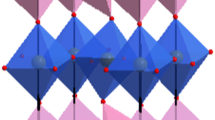Abstract
A new oxygen-deficient perovskite with the composition Ca(Fe0.4Si0.6)O2.8 has been synthesised at high-pressure and -temperature conditions relevant to the Earth’s transition zone using a multianvil apparatus. In contrast to pure CaSiO3 perovskite, this new phase is quenchable under ambient conditions. The diffraction pattern revealed strong intensities for pseudocubic reflections, but the true lattice is C-centred monoclinic with a=9.2486 Å, b=5.2596 Å, c=21.890 Å and β=97.94°. This lattice is only slightly distorted from rhombohedral symmetry. Electron-diffraction and high-resolution TEM images show that a well-ordered ten-layer superstructure is developed along the monoclinic c* direction, which corresponds to the pseudocubic [111] direction. This unique type of superstructure likely consists of an oxygen-deficient double layer with tetrahedrally coordinated silicon, alternating with eight octahedral layers of perovskite structure, which are one half each occupied by silicon and iron as indicated by Mössbauer and Si K electron energy loss spectroscopy. The maximum iron solubility in CaSiO3 perovskite is determined at 16 GPa to be 4 at% on the silicon site and it increases significantly above 20 GPa. The phase relations have been analysed along the join CaSiO3–CaFeO2.5, which revealed that no further defect perovskites are stable. An analogous phase exists in the aluminous system, with Ca(Al0.4Si0.6)O2.8 stoichiometry and diffraction patterns similar to that of Ca(Fe0.4Si0.6)O2.8. In addition, we discovered another defect perovskite with Ca(Al0.5Si0.5)O2.75 stoichiometry and an eight-layer superstructure most likely consisting of a tetrahedral double layer alternating with six octahedral layers. The potential occurrence of all three defect perovskites in the Earth’s interior is discussed.
Similar content being viewed by others
Acknowledgments.
We are grateful to Peter van Aken, Darmstadt, for his help with the EELS spectra. This work has been supported by Deutsche Forschungsgemeinschaft (grants SE 302/24-1 and /24-2) and Fonds der chemischen Industrie to F. Seifert.
Author information
Authors and Affiliations
Corresponding author
Rights and permissions
About this article
Cite this article
Bläß, U., Langenhorst, F., Boffa-Ballaran, T. et al. A new oxygen-deficient perovskite phase Ca(Fe0.4Si0.6)O2.8 and phase relations along the join CaSiO3–CaFeO2.5 at transition zone conditions. Phys Chem Minerals 31, 52–65 (2004). https://doi.org/10.1007/s00269-003-0375-6
Received:
Accepted:
Issue Date:
DOI: https://doi.org/10.1007/s00269-003-0375-6




